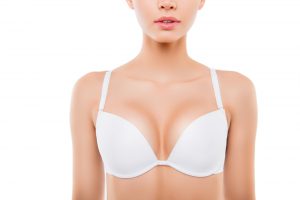 Breast augmentation goals include having soft and supple breasts after surgery. After breast augmentation, some surgeons recommend breast massage to help keep the breasts soft and supple. The breast massage is employed to help prevent and/or treat problematic “capsule” formation. Any smooth, non-reactive surface in the body—like a heart pacemaker—causes “capsule” formation. The “capsule” is reactive scar tissue that occurs as a normal healing response to a “foreign body,” in this case, a breast implant. All breast implants cause “capsule” formation to some degree. So “capsule” formation is a normal wound healing response to a foreign body. In the context of breast augmentation, “capsule” formation implies a problematic “capsule” surrounding the breast implant, causing the breast to feel abnormally hard and also causing discomfort.
Breast augmentation goals include having soft and supple breasts after surgery. After breast augmentation, some surgeons recommend breast massage to help keep the breasts soft and supple. The breast massage is employed to help prevent and/or treat problematic “capsule” formation. Any smooth, non-reactive surface in the body—like a heart pacemaker—causes “capsule” formation. The “capsule” is reactive scar tissue that occurs as a normal healing response to a “foreign body,” in this case, a breast implant. All breast implants cause “capsule” formation to some degree. So “capsule” formation is a normal wound healing response to a foreign body. In the context of breast augmentation, “capsule” formation implies a problematic “capsule” surrounding the breast implant, causing the breast to feel abnormally hard and also causing discomfort.
The scientific study of problematic breast “capsules” is very challenging due to multiple variables, including the type of implant filler (silicone or saline), type of implant shell (smooth, textured, or other), type of breast implant procedure (pocket type—subglandular, submuscular, subfascial, or other), differences in operator technique, individual response to breast implant material, observer variation, patient compliance (follow-up, medicine, massage, etc.), and unknown factors (bacterial colonization, subclinical infection, subclinical seroma, subclinical hematoma, etc.).
Despite the challenges of studying problematic breast “capsules,” some general concepts can be gleaned. First, some patients get problematic “capsules,” and some do not. In addition, a problematic “capsule” may be observed in only one breast in the same patient. The occurrence or absence of problematic breast “capsules” in any single patient is not 100 percent predictable. The relationship between the variables and problematic breast “capsules,” however unpredictable, can be utilized to lessen the probability of such an occurrence. Many plastic surgeons believe that breast massage can help prevent and/or treat problematic “capsules” after breast augmentation.
After breast augmentation, the goal is to keep the breast pocket potential volume larger than the breast implant volume. When the breast “capsule” volume—meaning the space around the breast implant—shrinks or “contracts,” the breast will feel more firm. It is (usually) not the breast implant that causes the firm feeling, but rather the tight “capsule” around the breast implant that feels firm. This occurs when the breast “capsule” pocket potential volume approaches or approximates the volume of the breast implant. This is a common reason breast implants feel too firm. Another cause of firm implants could be calcification of the implant “capsule,” making it like a bony shell. This situation can occur with breast implants that have been in place for many years. Both tight “capsules” and calcified “capsules” can also exist in the same patient, resulting in firm-feeling breasts.
If the goal is to have the breast “capsule” potential space (volume) larger than the actual breast implant volume, how is this achieved? First, at the time of breast augmentation, the breast pocket is intentionally made larger than the breast implant. This allows the breast implant to be “mobile” in the breast pocket. This is primarily true for smooth-shell breast implants as opposed to textured breast implants. After breast augmentation, the breast implant can be “massaged” to help maintain the size (volume) of the breast pocket. This is probably more helpful for saline breast implants than silicone breast implants due to differences in implant compressibility. Most patients can begin breast massage a few days after surgery, and then on a daily basis. The breast massage only takes a couple of minutes a day, so it is not time consuming. The breast massage is done by gently compressing the breast implant with the fingers to move the implant inside the pocket.
While difficult to study, breast massage probably does help prevent problematic “capsules” in a segment of breast augmentation patients, and probably does not do any harm in most patients. Close follow-up after surgery is helpful in early diagnosis of problematic breast “capsule” formation, which may improve the chances of a successful intervention. Beyond this summary, more complete information regarding breast massage after breast augmentation is available during your in-person consultation.
To make an appointment for a breast augmentation consultation, call Herring Plastic Surgery at 910.486.9093 or contact us online today.
Previous Post Next Post